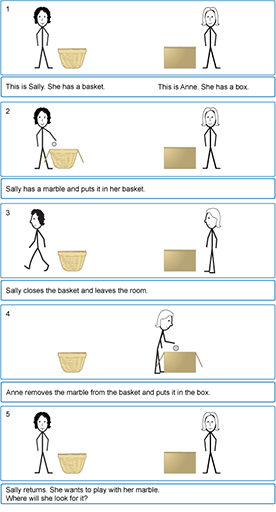1.3 The Sally–Anne false belief task
Activity _unit5.1.1 Activity 1 Try out the Sally–Anne false belief task
Simon Baron-Cohen used the Sally–Anne task to investigate whether autistic children could understand false belief. The following download contains an animation that illustrates this test and his results. After watching the animation, answer the three questions that follow it, and pay careful attention to the feedback.
You can find the downloadable Sally–Anne task at this link [Tip: hold Ctrl and click a link to open it in a new tab. (Hide tip)] .
You can find instructions for downloading and using the Sally–Anne task at this link.
If you can't use this download, or prefer not to, here is an image showing the key contents of the animation:
When this task is used with typically developing children, it is found that over the age of 4–5 years, most are able to correctly identify that Sally has a false belief about the location of the marble.
Activity _unit5.1.2 Activity 2 Children taking the Sally–Anne task
Now watch a short video, in which Baron-Cohen first tested two children with autism and then a younger neurotypical child on the task. Notice that most children with autism (around 80%) fail on the ‘belief’ question ‘Where will Sally look for her marble?’, while children in the two control groups mostly pass. What does failure on the belief question suggest? Note down your explanation.
Transcript
[TAP]
[TAP]
[TAP]
Discussion
Baron-Cohen and his colleagues argued that instead of 'putting themselves in Sally's shoes', the autistic children assume that Sally’s belief about where she will find her marble is the same as their own knowledge of where the marble really is. In short, the study suggests that children with autism have difficulty understanding another person's thoughts, which in this case are different from their own.
The basic finding of the Sally–Anne task has been
Note that the task does not offer a way of diagnosing autism. Not all autistic people fail it, and some neurotypical people may also find it difficult.
Over the decades since the Sally-Anne false belief task findings were first reported, their implications have been widely questioned and qualified. However, a quite common occurrence in autism is that a person fails to give some crucial information to another person. This could well reflect a problem in understanding other people's knowledge of a situation.
Activity _unit5.1.3 Activity 3 A real-life ToM problem?
Read the following extract, and explain how it fits with the idea that ToM is a challenge for autistic people:
One of the most recurrent problems throughout middle childhood was my constant failure to distinguish between my knowledge and that of others. Very often my parents would miss deadlines or appointments because I failed to tell them of these matters. For instance, my parents missed the school’s Open House in my fifth grade and my mom asked me afterward ‘why didn’t you tell us about it?’ ‘I thought you knew it’, I replied.
Discussion
Sarah seems not to understand that her parents don’t have exactly the same thoughts as she does. Because she has not told them about the Open House at school, they have no knowledge that it is due to happen.

